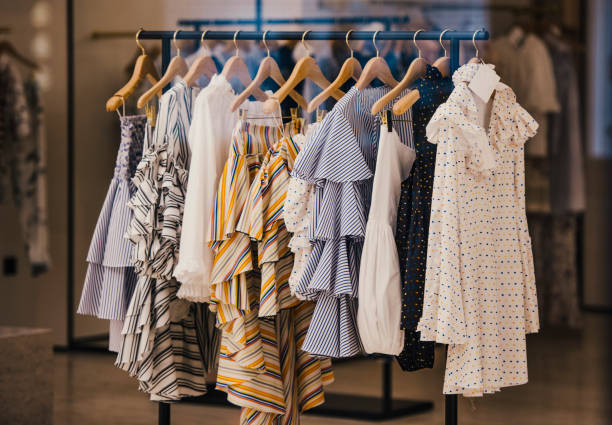Check Out the current Patterns in Boutique Fashion for every single Period
Check Out the current Patterns in Boutique Fashion for every single Period
Blog Article
Exploring the Evolution and Influence of Apparel on Modern Fashion Trends
The evolution of clothing has significantly affected modern-day style patterns, merging historical precedents with advanced developments. Renowned figures like Coco Chanel and Yves Saint Laurent revolutionized the style sector by introducing principles that focus on convenience and ease of access, which continue to reverberate today.
Historic Fashion Influencers
In the tapestry of fashion background, certain numbers have actually left an indelible mark, forming the patterns and styles that specify whole ages. Coco Chanel, a revolutionary developer, redefined women's style by introducing comfortable, classy garments that departed from limiting corsets. Her famous Chanel fit and little black dress have actually ended up being timeless staples in closets worldwide. Likewise, Christian Dior's post-war "New Look" in 1947, with its event of womanhood via full skirts and cinched waistlines, marked a go back to opulence and has actually remained to affect designers.
Elsa Schiaparelli is another essential figure, renowned for her avant-garde styles that integrated surrealist art, teaming up with Salvador Dalí to create wayward items that challenged traditional visual appeals. Her cutting-edge use of color and bold patterns reverberates in modern style. Yves Saint Laurent, meanwhile, democratized haute couture with prêt-à-porter collections, bringing path styles to the masses and setting a criterion for contemporary ready-to-wear lines.
These dreamers, to name a few, not only reinvented style in their times yet also set withstanding trends that resonate in today's fashion market, supplying a structure whereupon modern designers remain to introduce and construct. Their legacies underscore the significance of imagination and daring in vogue's ever-evolving narrative.
Technological Innovations in vogue
Amidst the dynamic landscape of the fashion industry, technological advancements stand at the forefront of innovation, improving just how developers develop and customers involve with fashion. The combination of 3D printing has transformed design procedures, allowing designers to try out complicated structures and sustainable products that were formerly unthinkable. This technology helps with fast prototyping, decreasing waste and speeding up production times.

Smart textiles, embedding modern technology into materials, are also transforming the sector. Innovations like temperature-regulating and self-cleaning fabrics supply enhanced performance and convenience. Wearable technology, integrating attributes like fitness tracking and interaction, includes a new dimension to style, combining visual appeals with functionality.
Cultural Shifts and Style
As technological advancements remain to improve the apparel industry, social shifts are equally prominent, redefining style and consumer preferences. Over the last few years, the increase of social networks platforms has sped up the dissemination of worldwide fashion trends, enabling varied cultural influences to converge and coexist. This electronic interconnectivity has actually promoted the fast exchange of concepts, causing a much more inclusive and diverse analysis of style that reflects the multifaceted nature of modern-day culture.
Social understanding and recognition have you could check here prompted developers to attract motivation from a broader range of ethnic and historic contexts, integrating standard themes with contemporary visual appeals. This fusion has actually led to fashion that reverberates with a larger audience, advertising a feeling of identity and belonging throughout various demographics. Additionally, the raising need for personalization has actually driven brands to offer personalized choices, enabling customers to reveal individuality while mirroring their cultural heritage.
In addition, moving social values have actually affected fashion, with inclusivity and variety becoming main themes. The sector has started to embrace designs and influencers of various type of body, ethnicities, and sex identities, tough conventional beauty requirements. This transformation highlights the power of social shifts fit the future of style, as navigate to this website style becomes a much more genuine expression of personal and cumulative identification.
Sustainability and Modern Layout
While the style sector proceeds to evolve, the vital for sustainability has actually ended up being progressively immediate, influencing modern-day layout techniques. The surge of slow-moving style, which highlights high quality over quantity, encourages consumers to invest in classic items instead than short-term patterns.
Moreover, modern-day layout is defined by its development in minimizing waste and advertising circularity. This method not just alleviates environmental influence but additionally boosts the social responsibility of fashion homes.

Future Trends in Fashion

Sustainability will remain to be a driving pressure in shaping future style trends. The market is increasingly taking on environment-friendly products and honest manufacturing techniques, replying to a growing customer demand for liable practices. Technologies such as bio-fabricated materials and closed-loop recycling systems are readied to redefine how garments is produced and taken in, minimizing environmental effect while keeping style and top quality.
Cultural shifts, consisting of the rise of inclusivity and diversity, will certainly also play an essential duty. As society ends up being more conscious of social issues, fashion is expected to come to be a platform for expression and modification. Developers will likely focus on producing collections that mirror a more comprehensive range of identities and experiences, promoting representation and ease of access.
Verdict
The evolution of clothing significantly influences modern-day style fads, where historic influences merge with contemporary layouts. This recurring advancement underscores fashion's duty as a mirror to social worths and technological development, suggesting a future abundant with technology and inclusivity.
The development of clothes has significantly affected contemporary fashion patterns, merging historic criteria with advanced innovations.Among the vibrant landscape of the fashion sector, technical developments stand at the forefront of technology, improving how developers produce and customers engage with style.While the style industry proceeds to develop, the vital for sustainability has come to be progressively immediate, influencing modern layout practices. As sustainability comes to be ingrained in modern layout, it paves the means for a more liable and mindful style industry.
The advancement of clothes dramatically affects modern-day fashion trends, where historic influences merge with modern designs.
Report this page